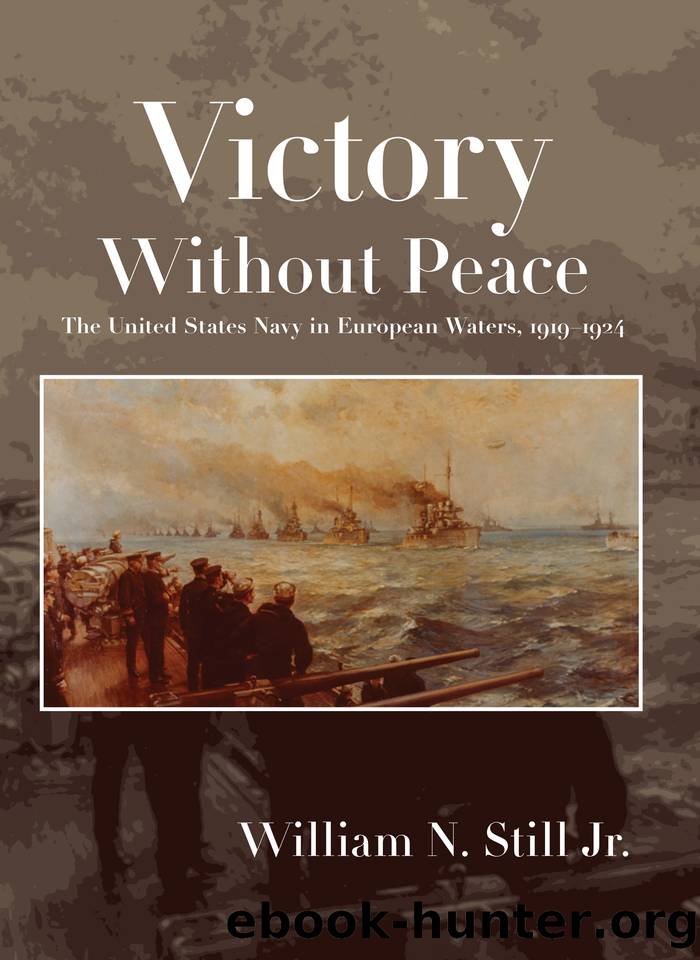Victory Without Peace: The United States Navy in European Waters, 1919–1924 by William N. Still

Author:William N. Still
Language: eng
Format: epub
Publisher: Naval Institute Press
Published: 2018-08-14T16:00:00+00:00
CHAPTER 8
REFUGEES AND RELIEF
Initially, the Navy’s primary missions in the Near East were supporting relief personnel and providing transportation for refugees. Admiral Bristol emphasized this point, and his officers believed it. Commercial interests quickly followed, but humanitarianism often played a larger role than trade in the Navy’s priorities.1 There was little need for a naval detachment in that region absent these two responsibilities. American relief efforts organized and administered by Herbert Hoover spanned Europe, but they were far larger in the vast region around the Black Sea. This work began immediately with the capitulation of Turkey and continued for several years. Congress appropriated funds for the ARA but initially specified that these funds were for “non-enemy countries” and designated races and nationalities: Armenians, Syrians, Greeks, and other Christian and Jewish minorities. An impressive number of organizations were involved in this effort. They included the Red Cross, the ARA, the Near East Relief (NER), the YMCA, the YWCA, and other religious associations. By the same act the Food Administration, created during the war, was authorized to purchase, transport, and distribute foodstuffs. This act would provide relief in Europe and the Near East and for American farmers as well; the years 1919–22 brought bumper crops and depressed domestic prices.2
Herbert Hoover, who headed both the ARA and the Food Administration, had not waited for congressional action. In January 1919 three NOTS ships carrying supplies and relief workers left the United States for the Black Sea. Others followed. Neither did the Navy wait. On January 18, 1919, Sims ordered Bristol to provide aid for relief projects as soon as Bristol arrived in Constantinople. Information poured into Bristol’s flagship about conditions throughout the Near East. Rumania was on the verge of famine. One food ship tried to reach Sulina, near the mouth of the Danube, but could not because the channel was too shallow. The cargo was unloaded at Constanza on the coast and carried by horse-drawn vehicles into the interior. Relief personnel provided by private organizations, government agencies, the American army, and others quickly fanned out throughout the Near East. The number of relief personnel in the Near East at any one time is unknown but was probably between five hundred and a thousand. Bristol’s chief of staff wrote, “Our Near Eastern Relief workers are all over the Near East and of course give us considerable concern for their safety. We will look out for them the best we can.”3
The United States had never declared war on the Ottoman Empire, as had the Allies. Perhaps for that reason, Hoover was informed even before relief officials arrived in Constantinople of the desperate needs in the areas bordering the Black Sea and ordered the dispatch of food-laden cargo vessels there. The Allies had blockaded the straits leading to Constantinople but, unlike in the postwar blockade against Germany, did not hinder relief ships. A naval vessel got through with some two hundred ARA personnel, “hospital units, nurses, drivers with motor trucks, tractors and other equipment to facilitate
Download
This site does not store any files on its server. We only index and link to content provided by other sites. Please contact the content providers to delete copyright contents if any and email us, we'll remove relevant links or contents immediately.
| Africa | Americas |
| Arctic & Antarctica | Asia |
| Australia & Oceania | Europe |
| Middle East | Russia |
| United States | World |
| Ancient Civilizations | Military |
| Historical Study & Educational Resources |
The Light of Days by Judy Batalion(1072)
First Platoon: A Story of Modern War in the Age of Identity Dominance by Annie Jacobsen(907)
Stalin's War: A New History of World War II by Sean McMeekin(864)
The Pacific War 1941-1943 by James Holland(805)
Walk in My Combat Boots by James Patterson(766)
The American War in Afghanistan by Carter Malkasian(744)
Victory's Price (Star Wars) by Alexander Freed(735)
The Vietnam War: An Intimate History by Geoffrey C. Ward & Ken Burns(725)
Blood and Ruins: The Great Imperial War, 1931-1945 by Richard Overy(690)
Operation Pedestal by Max Hastings(684)
Concepts of Space by Jammer Max;(669)
Cold War (Alexander King Book 2) by Bradley Wright(663)
Extreme Fitness by Chris McNab(655)
The Madman Theory by Jim Sciutto(652)
Flying Tiger by Samson Jack(640)
World War II Infantry Fire Support Tactics by Gordon L. Rottman(614)
Pathfinders by AL-KHALILI JIM(611)
Panzerkrieg by Mike Syron(602)
Hitler’s Pre-Emptive War: The Battle for Norway, 1940 by Henrik O. Lunde(587)
